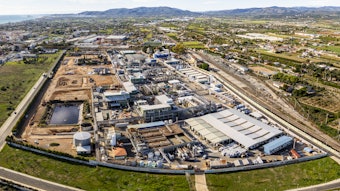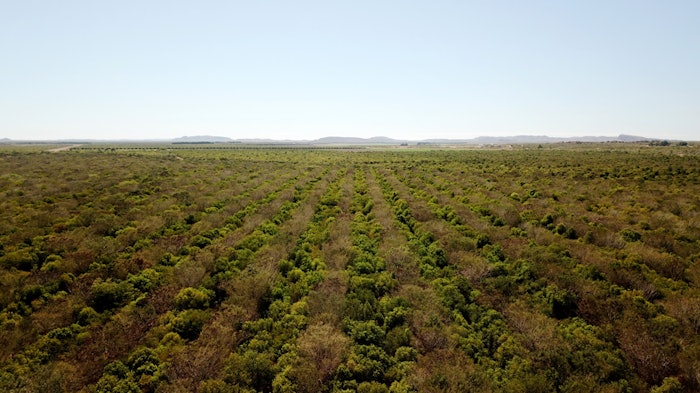
This piece is also available in French.
Abstract
In light of the laudable EU Green Deal perspectives for a cleaner and safer environment, this article presents a holistic approach to the world of natural scents and extracts, and in particular essential oils, from different angles such as their intrinsic complexity, socio-economic importance and vulnerability, underlying dynamics and reflections on petrochemical alternatives for our society. Forests, shrubs, flowers and essential oils are very complex and fragile worlds with many similarities. All plants produce very large amounts of Volatile Organic Compounds (VOCs) as a result of their metabolism. These biogenic VOCs are numerous (more than 1,000 types of volatile chemicals) and have been part of a natural ecosystem for millions of years. Many VOCs have what we have found to be identifiable functions, such as a means of communication (between plants, but also between plants and animals) or protection against climatic factors. Some of these VOCs have an odor and determine the different scents between flowers, shrubs and forests. Their beneficial effects on human health are becoming better understood; these same VOCs are also the basis for that relaxing walk in the woods we love. Most essential oils are produced by the steam distillation of plants, flowers, herbs, barks and woods, and the resulting natural oil contains the valuable VOCs captured from the biomass. As such, essential oils carry the natural footprint of plants.
Essential oils (citrus and non-citrus) and forest extracts (mainly from conifer trees) are produced in every continent, in more than 60 countries, including many European countries such as France, Spain, Italy, Hungary, Germany, Romania, Slovakia, Greece, Belgium, Croatia, Bosnia, and forest extracts mostly by Sweden, Finland, Poland, Germany and Austria who play a predominant role. The total amount of essential oils averages 300,000 metric tons (MT) worldwide (including turpentine essential oil derived from conifer trees). Essential oils are mainly used in fragrances (125,000 MT per year), followed by flavors (65,000 MT per year), pharmaceuticals (40,000 MT) and the remaining 70,000 MT (mainly forest essential oils) are used as renewable specialty products such as resins, adhesives and inks (F-1).
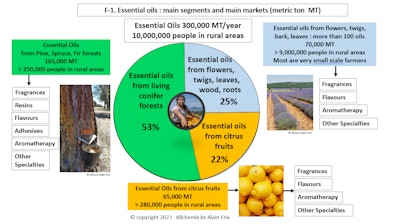
Essential oils compete with petrochemical ingredients in the fragrance and flavor sectors. Petrochemical ingredients dominate in these industries, mainly because petrochemical derivatives can provide a low-cost alternative to natural products, sometimes because petrochemical derived ingredients can offer unique olfactive qualities, or better functional properties than naturals, such as stability in home cleaners, etc.
The fragrance market is a good example of the importance and vulnerability of natural products. Today, petrochemicals account for over 70% of fragrance ingredients, compared to only 30% for essential oils and other forest products. Interestingly, half of the petrochemical ingredients in fragrances are nowadays produced mainly in China, often at the lowest cost using coal as the main energy source for manufacturing. Biotechnology also represents a growing competition for essential oils, but it is not a significant volume because their production costs are still far too high, not to mention their GMO—questionable aspects for some, which slows their growth.
In addition, main markets such as perfumery markets are now under unprecedented cost pressures, leading perfume manufacturers to progressively replace essential oils and other natural extracts with cheaper petrochemicals or other synthetic substitutes. In the last 50 years, natural ingredients such as essential oils have lost a significant share to petrochemicals, some naturals are even disappearing. Farmers (and the entire natural ingredient supply chain) are being overwhelmed by a combination of hurdles, they are under pressure to guarantee availability, at cheaper prices, while complying with often excessive regulations and certifications from many compounding and consumer goods companies. However, most of the aromatic crops grow in remote places, the essential oils obtained from them are often in the hands of small and medium sized enterprises (SME) who are not equipped to deal with additional complexities and more stringent regulations. The essential oil industry needs time to adapt cultivation methods and extraction technologies, time to properly train farmers and processors, time to produce and present additional peer-reviewed safety data on essential oil products.
Favorable results will be achieved if regulators and the essential oil industry work together to find sensible and pragmatic ways to encourage natural product processors to reinvest. Clear, predictable, and realistic expectations are needed, with mutual guidance on how to improve sustainability and the circular economy. This requires a two-way approach that involves people from both sides, business and government regulators. Such partnerships can generate new momentum, and there are fascinating examples such as the creation of new forests in Australia, with the support of the authorities and industry, bringing into the world millions of sandalwood trees. Finally, a forest that offers economic value while being managed sustainably is the best guarantee against deforestation. In this way, a responsible essential oil industry enhances the value and preservation of forests and plants, and acts as a good provider of local jobs in remote areas.
One should not forget the principle of proportionality; farmers, pickers and tappers are at the base of some 300,000 MT of essential oils annually produced. Compared to nature's 1,000,000,000 MT of scents released every year by forests, the essential oil segment is several thousand times smaller. However, for tens of millions of farmers and pickers, this industry is vital; it is a basic, substantive need, enabling them to avoid malnutrition while providing access to education and other basic needs for their families. Even a one-year distortion in demand for essential oils is enough for farmers to turn to other livelihoods. Indeed, many cannot afford to wait and see how markets will develop; they live from day to day in rural areas with poor social systems.
Regulators and politicians have a great responsibility in preventing the loss of biodiversity in essential oils and extracts from forests, and the loss of income for rural farms in both developed and developing countries. It is also about preserving a cultural heritage, a world patrimony that emerged more than 7,000 years ago, a long period of time during which there is undeniable evidence that mankind mastered the chemistry of naturals, the same naturals that one can find in forests. We must not forget that the history of humanity has been closely linked to forests for millions of years. Paleoanthropologists are gathering evidence that the first pool of humans evolved in forest ecosystems. The relationship between the human body and forests, and thus their biogenic VOCs, is probably the result of a very long evolution. This adaptation could not happen the same way with petrochemical VOCs, because crude oil has only appeared on a massive scale in the last two centuries, after being buried for millions of years between layers of sedimentary rock deep below the earth's surface.
The implementation of the European Green Deal must consider the complexity and fragility of the essential oils industry. If regulations on essential oils become too stringent, many multinational compounding and consumer goods companies will not be able to keep using them; they will phase them out as the regulatory burden and associated costs become excessive. These natural products will simply be replaced by petrochemicals or biotech GMOs, often produced in-house by the same multinationals. This would wipe out an entire natural supply chain and further strengthen the dominant position of some large compounding companies. So, it is not the final formulator who will suffer most from over-regulation of natural products, but consumers and many small and medium sized family-owned businesses (many of which are still based in Europe) that have been processing, extracting, and refining quality natural products, sometimes for over a century. And behind them, the millions of invisible farmers who are never heard from and who will be deprived of their main resources for survival.
Many of them will see their lavender, patchouli, vetiver, agarwood, ylang-ylang, jasmine, etc. replaced by petrochemical derivatives of oil, gas and coal. This can certainly not be the objective of the EU’s Green Deal and one must be aware of the adverse effects of any unilateral decision if it is based on too narrow of an approach.
1. Introduction
Every day, humans live and experience a world full of natural (not produced by man) aromatic botanicals. We breathe every minute, yet we are not always aware of our experiences. Often, these invisible aromatic sensations are produced in nearby forests…not surprising, our relationship with forests continues to be important, if not fundamental. Regular visits to the forest are known to be beneficial to health, a concept ingrained in culture and traditions. Don’t we always feel invigorated after a walk among these tall, cellulose-rich living organisms? While bathing in the forest is known to reduce the incidence of stress-related and lifestyle-related diseases, it is also recommended to relieve allergic respiratory diseases and asthma.1,17 But there is more, much more.
2. Trees are Perfumers
What we may forget, or simply do not know, is that this invigorating walk is a walk into a dense natural perfume factory. Yes, trees are perfume plants; they produce "biogenic" Volatile Organic Compounds (VOCs) and are not in short supply. Recent estimates show that forests emit about 1 billion metric tons of VOCs every year.2 Not surprisingly, these VOCs are a reflection of plant metabolism; trees (and all plants on earth), capture billions of metric tons of carbon dioxide from the atmosphere each year and use it as a natural catalyst to produce the active biochemicals desired. They patiently incorporate the carbon elements into a very complex biomass, forming many types of biochemicals such as cellulose (whose fibers are each composed of thousands of glucose units), hemicellulose (composed of many other types of sugar units), and lignin, another organic polymer which is an extremely strong binder for cellulose and hemicellulose, largely responsible for the stiffness of wood. Several thousands of other biochemicals are produced daily by trees, a vast pool of forestry molecules that eventually find many industrial uses, such as construction wood, plywood, fiberboard, paper, cardboard, energy, and a variety of useful molecules for mankind known as "forestry chemicals" which will ultimately become parts of our daily lives, such as cleaners, inks, adhesives, cosmetics and perfumes.
3. From Carbon Capture to VOCs
When a plant makes biochemicals from carbon dioxide, it produces by-products that are released into the atmosphere every second, every day and night, winter and summer. For this reason, forests always smell like forests. A pine forest reminds you of its "VOCs" in every breath you take, its typical scent is always present. As with animals, the metabolism of plants continues uninterrupted until death occurs. In fact, it's all about survival; many of the biogenic VOCs have a protective function, some regulate a tree’s canopy temperature, some are messengers to other plants, while others can repel insects. Only a few of these mechanisms are understood, and there is so much more to discover. Forests are by far the largest biogenic VOC emitters on earth, especially our treasured tropical forests like the Amazon or the Congo Basin.
4. What is “pollution”?
Some regulators perceive these VOCs in the forest as "polluters," but can we really qualify a system that has been self-regulating for millions of years this way? We need to better understand plant biomasses, and their interconnections with the rest of our world, before we could call any of its product’s pollutants. Each chemical must be understood in its complex interaction with thousands of other chemicals, but we do not have such analytical models today. Forests are not the only ones that produce VOCs—all plants produce them, and every part of the plant plays a role—leaves, fruits, flowers, and even roots, release most of the biogenic VOCs into the atmosphere. Who can resist the delicious smell of a perfect peach or a fragrant strawberry? It is their volatile organic compounds that increase your desire to eat them. While plants are the largest biomass on Earth, bacteria and fungi are the second most important biomass generators, although it is not clear how many VOCs they release. We know, bacteria are already responsible for significant amounts of alkenes, alcohols, ketones, and terpenes and fungi are rich in benzene, aldehydes, and ketones.1,8
5. Talking about Biodiversity
The diversity of plant VOCs is high; more than 1,000 different volatile chemicals are released from plants and from trees, the main one being a 5 carbon chemical isoprene (around 50% of all biogenic VOCs is isoprene, probably because the isoprenoid metabolic pathway is a major one in plants), followed by methanol, acetaldehyde, alpha-pinene, beta-pinene, d-limonene, beta-ocimene, sabinene, myrcene, camphene, cineole, camphor, linalool, para-cymene, delta-3-carene, linalool oxide, borneol, bornyl acetate, terpinene-4-ol, copaene, humulene, alpha-phellandrene, betaphellandrene, alpha-terpinene, alpha terpineol, alpha terpinolene, bergamotene, longifolene, methyl jasmonate, methyl salicylate, alpha thujene, beta farnesene, then hundreds more terpenoids and other smaller molecules, many of which are likely still to be detected. 9 Many of the above-mentioned forest monoterpenes have anti-inflammatory properties and reduce oxidative stress. It is also known that the olfactory perception of the pleasant scents of trees and flowers have a positive effect on our psychological well-being. And most of these molecules mentioned above are basic perfumery ingredients as well.
6. A Very Large Natural Cloud
It is reported that the annual emission of forest monoterpenes could reach over 400 million metric tons. This is not surprising, as scientists have estimated that nature produces up to 40,000 different types of terpenes. Physical stresses such as plant injury and heat stress lead to increased release of other types of VOCs, particularly 6-carbon fatty acid derivatives such as cis-3-hexenol (this is the smell of freshly cut grass, which is a result of cutting their leaves), cis-3-hexenyl acetate, cis-3-hexenyl butyrate, cis-3-hexenyl valerate, a group of molecules that could release over a hundred million metric tons worldwide. Forests also produce significant amounts of benzene and phenylpropanols.1,3,4,5 Insects, fires, high winds, and high humidity also affect the release of VOCs by trees, with deciduous trees apparently releasing even more VOCs than conifers. Many types of chemicals are involved in communication between plants or between plants and animals. This area of phytohormones is far from well understood, but there has been some progress in identifying some messengers such as ethylene, jasmonic acid, etc.1,6,7
7. Importance of Essential Oils
Essential oils are the result of distillation (using steamed water) and extraction of plants, flowers, fruits, herbs, barks, woods and root, and the resulting natural oil contains the valuable components of the biomass. In fact, the scented molecules already formed by the plant are captured by the distillation process, before the plant has had a chance to release them into the atmosphere. Essential oils therefore carry the olfactive footprint of plants. The essential oils are in very small quantities compared to the massive forest VOCs. The world of essential oils is microscopic and not always well understood, often perceived as complex as it revolves around the use of more than 200 essential oils mainly in fragrances, flavors, pharmaceuticals and aromatherapy. They have all one thing in common—they are big work providers for people, especially farmers. There is a worldwide biodiversity of essential oils, with more than 200 commercial essential oils, some of which have a history of more than 7,000 years, true vectors of culture and tradition. Essential oils are vital resources for farmers in both developed and less developed countries, they are produced in more than 60 countries.
The world is producing some 300,000 MT of essential oils:
- 165,000 MT of gum turpentine oil (and some other conifer extracts such as pine needle oils) obtained from living trees: Many people are not familiar with gum turpentine, though it is the world’s biggest essential oil. Gum turpentine is obtained from the resin exudates of living conifers (mostly pine, spruce and fir) through ancestral tapping techniques; tens of thousands of people across the world manually collect resins from millions of trees, revisiting them several times a year. After distilling the natural resin, a fully natural gum turpentine essential oil is obtained. This ancestral technique preserves trees and forests, providing work to many inhabitants of rural areas, particularly in Asia and South America. It is also an incentive for local populations to protect their surrounding forests, as it is a source of income through the tapping activity. Over 250,000 tappers worldwide benefit from this activity.16
- 70,000 MT of essential oils from flowers, twigs, leaves, bark, wood and roots: These are most diverse essential oils such as cornmint, spearmint, peppermint, eucalyptus, clove, lavandin, lavender, citronella, litsea cubeba, patchouli, sage, lemongrass, tea tree, anise, ginger, nutmeg, vetiver, coriander, cinnamon, geranium, basil, petitgrain, verbena, cassia, caraway, marjoram, palmarosa, rosemary, fir needle, amyris, fennel, artemisia, fenugreek, helichrysum, thyme, dill, juniper, cypress, ajowan, chamomile, cajeput, cananga, valerian, lovage, hyssop, tarragon, jasmine, rose oil and another 100 different essential oils and other natural extracts, providing work to many millions of mostly small scale farmers and pickers.
- 65,000 MT of essential oils from citrus fruits: These are familiar essential oils mainly obtained by cold-pressing the peel of more than 20 types of citrus fruits, such as orange, lemon, lime, tangerine, grapefruit, bergamot, yuzu, etc. They also are very important for many local communities across the globe. Essential oils are used in many industries such as fragrances, flavors, aromatherapy, pharmaceutical, organic phytosanitary products and other ancillary industries (F-1).10
8. Illustrate the Dynamics of Essential Oils in the Fragrance Industry
Let us analyze the dynamics of essential oils in their most important applications —perfumes. The calculations which follow are estimations of a fragrance’s aromatic components, in metric tons following correction referring to all masses being expressed as 100% pure products (F-2).
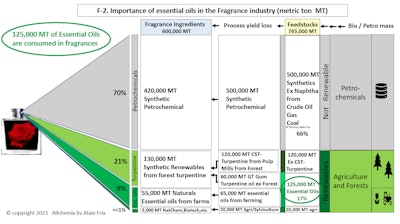
⦁ Essential Oils and Extracts: Approximately 125,000 MT of essential oils are used each year in the fragrance industry, some 17% of the total fragrance ingredient feedstock. In addition to being an essential raw material for perfumes, essential oils are the only real provider of natural ingredients—about 55,000 MT of these natural oils will be used as final ingredients in perfumes, or 9% of all fragrance ingredients worldwide (F-3). As their production provides work for millions of farmers and pickers, essential oils are by far the most important socio-economic contributors of the fragrance industry. Essential oils are an important driver to make fragrances "greener," more natural, more renewable.
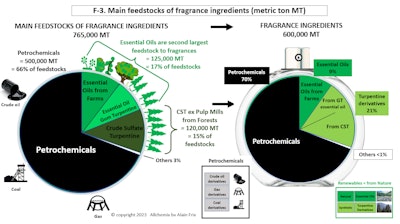
⦁ Turpentine Derivatives: These derivatives are obtained from two types of turpentine:
- Gum Turpentine (GT) Out of the world pool of 165,000 MT of natural gum turpentine oil, 60,000 MT will then be further processed into 45,000 MT of various fragrance ingredients.
- Crude Sulphate Turpentine (CST) This turpentine is also extracted from pine trees, but as a by-product of sawmills/paper industries. CST is not considered to be an essential oil as it has been sulphated. Approximately 120,000 MT of CST, or some 15% of feedstocks to fragrance ingredients, are processed into 85,000 MT of fragrance ingredients each year.
While both CST and GT are all of natural origin, their derivatives are mainly produced through catalytic chemical processes, as such these derivatives are mostly all synthetic. Turpentine derivatives from CST and GT account for up to 130,000 MT, or 21 % of all fragrance ingredients worldwide (F-3).
Other industries also consume turpentine derivatives, such as agrochemicals, polyterpenic resins, solvents, pharmaceuticals and camphor. As these are natural and sustainable products, more industries will require larger quantities of turpentine derivatives as a renewable raw material source in the near future, at least if regulations allow. 10,13
⦁ Petrochemicals: All petrochemical derivatives are synthetic and not renewable. Petro-derived aroma chemicals are prevalent in fragrance ingredients; up to 420,000 MT per year are used in perfumes, petrochemicals represent about two third of the perfumery ingredient’s feedstock.
Many petrochemical fragrance molecules aim to mimic existing natural chemicals, but often not exactly, as petrochemicals tend to be predominantly racemic mixtures, which means that they may not have the same chirality properties (nor always the same physiological effect) as the natural molecule they are trying to imitate. Some petrochemical molecules are entirely invented, which means that they are not (or not yet) found in nature, but offer unique properties, such as very delicate notes, powerful effects, better stability in detergents and cleaners. These properties are welcome in the perfumers' palette, as the fragrance must adhere, not discolor and not interact overly with the other substances that define a detergent, cleaner, fine fragrance or cosmetic. Petrochemicals are by far the cheapest fragrance ingredients and the main driver for the expansion of fragrance in the world.
Petrochemical companies are launching initiatives to replace part of their fossil feedstocks with certified renewable feedstocks through a biomass balance approach. This principle involves the measured injection of biomass into the traditional petrochemical feedstock at the refinery. This ratio will be certified throughout the production chain according to the proportion of "green versus gray" carbons, resulting in a certified partially renewable, synthetic product. This involves rigorous certification schemes and possibly carbon credit schemes where the biomass is remote or where it is practically impossible economically to transport it to the refinery.
⦁ Biotechnology and Natural Chemicals: These natural chemicals are produced complying with either United States or European natural chemical protocols. An estimation of annual volume is 2,000 MT, which includes biotechnologically produced products.10 Their use in fragrances is extremely low due to their high price, usually above 200 euros/kg of final material, and their olfactory profile which is often different from that of natural extracts and does not always meet the requirements of perfumers. A majority of these natural chemicals are manufactured in China, sometimes without clear evidence of full compliance with United States or European natural processes, yet these materials are still available with the desired certificates for the fragrance and flavor industries. This deserves more attention and possibly an investigation by the authorities, as it is very unfair competition for producers of genuine natural chemicals. It is very likely that some large respected multinational companies buy these dubious products, while there are sufficient tools and equipment to detect falsifications. It must be admitted that many of these doubtful naturals are bought at significantly lower prices.
9. The Shift from Natural Ingredients to More Petrochemicals and Coal…
Over a period of 50 years, natural ingredients have lost much of their share to petrochemicals, mainly due to cost factors and limited availability, while petrochemicals are cheaper and much more abundant, even these are in the hands of a limited number of large companies.
Today, many natural ingredients are on track to disappear from the fragrance palette as regulatory pressures on essential oils continue to increase at an astonishing pace. Over the last 20 years, many western companies have moved the production of their petrochemical ingredients especially to China. Aside from the less sustainable distances and geopolitical risk profile associated with this shift, there is often-forgotten environmental issue that we cannot deny; most of the energy for Asian manufacturers especially in China—comes from coal; while Western manufacturers mainly use gas and oil, which release proportionally far less carbon dioxide. The author estimates that more than 50% of current petrochemical fragrance ingredients come from raw materials produced in China.
10. Comparative Carbon Requirements from Various Industries
Petrochemicals are produced specifically as key products for much larger industries besides the perfume industry. Petrochemicals are the main source of plastics (400,000,000 MT/year) but also the main raw material for other applications such as construction, textiles, agrochemicals, solvents, vitamins, printing, etc. The cumulative consumption of fossil carbon to produce consumer goods probably amounts to over 750,000,000 MT/year.10 These figures are still small compared to the all-powerful energy industry, which probably consumes over 14,000,000,000 MT/year of fossil carbon.12 Compared to these industries, the essential oil planet is extremely small to almost negligible, with its 300,000 MT of scented natural molecules. (F-4)
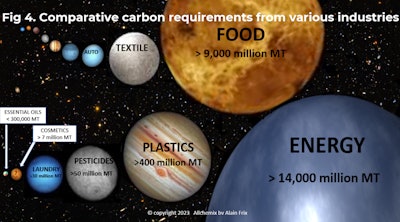
In fact, the comparison is more astonishing when you consider that a single crude oil sea tanker (300,000 MT) could carry by itself the entire world's production of essential oil. The crude oil industry probably produces more than 5,000,000,000 MT of crude oil per year (F-5), or more than 16,000 sea-tankers, producing massive amounts of petroleum VOCs such as toluene, benzene, xylene and other related products, which are known to have adverse effects on the human body. It is also interesting to compare the small size of the essential oil industry, with its annual 300,000 MT of pleasant-smelling biogenic hydrocarbon molecules, with the weight of biogenic VOCs released by nature, the latter very likely exceeding 1,000,000,000 MT per year (F-5).1 The concept of proportionality should never be forgotten. How much smaller could the essential oil industry be?

11. Differences between Petrogenic VOCs and Biogenic VOCs
Crude oil or a crude oil composition, is an unrefined substantially liquid mixture of hydrocarbons, resins and asphaltenes, extracted from geological formations underground and formed from large quantities of dead organisms as a result of decay, heat and pressure over millions of years.
The exact composition of a crude oil varies from location to location depending on the materials from which, and the conditions under which it was formed. Crude oils are highly flammable.
These petroleum substances were formed from the remains of animals and plants (diatoms) that lived millions of years ago in a marine environment, buried for millions of years between layers of sedimentary rock deep beneath the earth's surface, so—in contrast to biogenic VOCs—there was probably little or no interaction or adaptation between living organisms and petroleum VOCs. It should not come as a surprise that crude oil and many of its VOCs are found particularly toxic to humans and other living organisms. This very different history is another fundamental distinction between biogenic and petrogenic VOCs.
We can also assume that crude oil contains few or virtually no terpenes, or certainly in the same state as the terpenes present in essential oils, as the degradation of ancient biomass over millions of years has resulted in the transformation and degradation of the original terpenes. Further research is needed to identify clear markers of current biomass versus petromass, as these are two very different product families in terms of content, safety, size, and socioeconomic dynamics and should therefore be clearly separated.
12. Sustainability is Much More than Carbon Footprint Claims
Sustainability is a concept that is prevalent in many recent discussions and plays a key role in future investment decisions. However, people may not always fully understand what sustainability is really all about; they often forget the social aspect.
Sustainability can be defined as a complex and dynamic balance between economic (increased yields, energy savings, etc.), environmental (renewable feedstocks such as biomass and energy, waste reduction, biodegradability, biodiversity, preservation of natural resources such as water, soils, etc.) and social matters (fair trade, profit sharing, access to genetic resources, rural economy, women empowerment etc.)
Some companies, especially chemical producers, still express their sustainability efforts–sometimes myopically—through carbon footprint estimates. But carbon footprint itself is absolutely not a guarantee of a sustainable contribution to biodiversity, biodegradability, fair trade, rural employment, and so many other indicators that warrant a balanced business model. Social criteria are integral to the sustainability picture of each ingredient, and it is of increasing emotional value to many consumers in their purchase decision.
Millions of farmers, laborers and pickers are highly dependent on the essential oil sector. Their lives form the third pillar of sustainability, the human footprint. In fact, there are very few, if any, entirely perfectly sustainable solutions, and here again each feedstock has its advantages and its inconveniences.
Often, a very good carbon footprint comes at the cost of a reduced social impact and vice-versa. In the end, a successful sustainable company is one that adopts the challenge to continuously improve on its own internal framework, year by year, regardless of whether it transforms petrochemicals or agricultural products into a fragrance ingredient. The progress and desire to improve is more important than the score one keeps.
Moreover, the sustainability scores of both petrochemical-based and natural-derived industries are complementary. In other words, their weaknesses are different.
13. Essential Oils are a Big Provider of Rural Jobs
Cultivation, harvesting, and processing botanicals has a significant impact on rural welfare, an aspect often forgotten. The world needs to improve its efforts to provide work and income to rural communities, often operating in very remote areas. Experts from IFEAT (The International Federation of Essential Oils and Aroma Trades) have estimated that over 10 million farmers, pickers and tappers are saved from poverty thanks to the aromatic crops which are produced, often on their small plots of land and at times with very ancient techniques. IFEAT provides high quality information on the socio-economic aspects of many essential oils. These reports are also regularly published in IFEATWORLD. The same IFEAT is organizing educational courses on essential oils, explaining the diversity of their production and applications, and their uniqueness from an economic standpoint, under the leadership of the chair of IFEAT Education Committee Alan Brown.
It is a moral pledge, by some, to better support these challenged and often impoverished farmers, by generating corporate reports and obtaining various certifications.
Without work, the situation of these families becomes very precarious, many would have to leave their rural villages and move to the cities in search of an income. This is fueling migration–youngsters that don't make enough money in the villages have little to no choice but to migrate out of the countryside by millions, driven by hope and desperation to seek sustentative opportunities in big cities. Some would even risk their lives, like the people who cross the Mediterranean Sea in terrible conditions in search of a better life in Europe. Everything is somehow interconnected.10
14. Natural Products are Way Too Cheap
There is a real cost for sustainable practices. Farmers, especially small scale-farmers, are by far the weakest link in the full value chain of essential oils. While consumer goods companies rightfully impose more sustainability requirements and regulations on their entire supply chain, it is the farmer who mostly gets hit by the domino effect. As explained previously, over 10 million farmers and pickers, in the case of the essential oil industry, live at or just above the poverty level. They cannot be made the sherpas of sustainability. They need to be supported financially and socially and be educated in sustainable practices.
Unfortunately, the prices that are being offered for their natural products often do not allow them to properly invest in better practices and to implement new technologies. Consumer goods companies and brands need to educate consumers that there is a premium to pay to really improve the livelihood of the farmer and the environment. Some consumers will agree to pay a premium if they understand why they must pay more and how these premiums impact our planet.
Therefore, traceability needs to go in both directions—consumers need the ability to follow a product from the farmers’ hands, but they also need verifiable evidence that the price premium effectively goes to the farmers and better farming practices. Blockchain technologies could possibly be a solution, but millions of farmers still have no access to cell phones. Only then will sustainability be truthful and impact the entire product lines, much more than today’s initiatives, which are often limited and selected by major companies as required.10 And yes, petrochemicals are also far too cheap, considering the environmental costs associated with their use.
15. Effects on Rural Economy, Food Chain and Biodiversity
Some people often hastily claim that the essential oil industry has a negative impact on biodiversity and that it competes with food in terms of land use.
They may not always be aware of the small size of the essential oil industry compared to food production. Nor are they aware of the efforts and successes of the essential oil industry in preserving biodiversity and its amazing achievements including the creation of new forests and protecting endangered species.
Of the 300,000 MT of essential oils, 60,000 MT of citrus oils are produced from by-products of the food (fruit juice) industry. This leaves 240,000 MT of essential oils that could potentially 'compete' with food crops, although most of these essential oils come from conifer forests located in remote mountains, where food is not produced on a big scale.
The UN FAO has estimated in 2021 that annual primary food crops exceed 9,000,000,000 MT.14 The 240,000 MT of annual essential oils production represent an extremely small fraction—there is only one kg of essential oil produced for every 37,500 kg of food produced. Moreover, some previous estimates suggest that the cultivation surface area of essential oil crops in relation to food crops is no less than 1 in 10,000.15,18 The disproportion is such that it is fair to believe essential oils do not compete with food. In fact, the opposite is rather true—essential oils can be a complementary crop, supporting the farmer between two food crops.
A good example is the Indian cornmint, Mentha arvensis, one of the largest essential oils in the world with a production of almost 40,000 MT, and a good source of income to several millions of Indian farmers. It shows how mint crops complement food crops on the same field—these farmers take short duration mint crop in the summer season (sown and harvested between March and June), which is after the harvesting in spring of “winter“ food crops (sawn in November or December) such as potato, mustard, lentil, Bengal gram or wheat, barley, peas. The mint crops are harvested before the planting in June/July of rainy season food crops which is mainly rice or pigeon-pea. Mint crops are important crops as they can double the (still very low) earnings of farmers, diversify their income, which is extremely important with climate change factors making crops overly less predictable.
Some producers of biotechnology products often claim that they provide a great alternative to “endangered” species, citing Santalum album, the East Indian sandalwood. It is true that this tree was almost extinct due to grievous over-harvesting in India, three decades ago. In the late 1990s, the Forestry Department of Western Australia began to grow East Indian sandalwood trees as part of a global conservation program. Santalum album showed promising potential. Today, more than 10,000 hectares of arid savannah landscape in Kununurra (Western Australia) have been transformed into an immense plantation of sandalwood trees, creating a new ecosystem, and providing income to the local population. Millions of trees today define a new landscape, creating a new source of sandalwood essential oil, which are perfectly managed according to the principle of sustainability, as compared to when this same species was on the brink of extinction several decades ago. Such projects should be acclaimed, as they are true vectors of biodiversity preservation, they are the fruit of 25 years of patient investment and dedication. However, still today some producers of chemical alternatives continue to spread the idea that Santalum album is almost “on the verge of extinction.” Nothing could be further from the truth, and the best evidence of this is the millions of Santalum album trees that stand beautifully tall in Australia, as well as new plantations in other parts of the world. Once again, a forest that offers economic value while being managed sustainably is the best guarantee against deforestation.
16. Certificates, Regulations & Casualties
In recent years, further requirements such as renewability, traceability, sustainability programs, organic or vegan, and compliance with the rules of a myriad of other certifying bodies have added a sizable burden and complexity, especially to the farmers.
Although the intention is undoubtedly good, these additional constraints have proven to be very demanding to many small producers, as they lack the personnel or expertise to complete the paperwork being requested. Ultimately many small players discontinue or sell their business to larger entities, which are facing continued consolidation themselves. The pond of raw material producers is being drained at an alarmingly fast rate because of excessive and often unnecessary regulations. This leads to a uniformization of ingredients, the constitution of major compounding houses which goes against other fundamental principles of these same regulations. We need to be more responsible, and that means protecting farmers from over-regulation and over-certification.10
17. Essential Oils and Safety Assessments
Regulatory bodies from the EU and other regions seem to struggle to understand natural complexity. The current mindset towards safety assessment protocols—evaluating natural complexes according to their individual constituents—is of great concern. This approach implies that the NCS’s (Natural Complex Substance), like essential oils, will react as if each individual component were to behave in isolation. This has been proven on several occasions not to be entirely the case. For example, several studies performed by the RIFM (Research Institute for Fragrance Materials) in collaboration with IFEAT indicate that the genotoxicity profile of whole oils containing chemicals of concern often demonstrates a much better profile than may be expected based on individual component analysis and pass the various genotoxicity endpoint tests. As an example, NCSs such as rose oil, which contains methyl eugenol, yielded favorable results, contrary to similar test results conducted on methyl eugenol alone, which by itself is deemed to be unsafe.
The approach to breaking down essential oils into individual constituents and establishing their safety profile based on algorithms using existing chemical databases could likely save costs and facilitate bureaucratic documentation, but it does not necessarily reflect reality.
There is only one way to accurately assess essential oils safely and that is by testing the whole essential oil per se. Under the leadership of IFEAT, RIFM conducted genotoxic tests on more than 70 essential oils over the past five years, and, the tests conducted so far have not revealed any genotoxic concerns for almost all, as only a very few oils need to undergo further testing. Therefore, in various cases, the interactions between the constituents in NCSs attenuate certain properties and characteristics of the individual constituents in a favorable manner.
Recent studies conducted by other institutions on various essential oils indicate the physiological effects observed with the individual key constituents of these oils were very different from those observed with the entire oils. This is another strong indication that essential oils are very complex mixtures, and that it is essential to study whole oils rather than their constituents individually in safety assessment.19
Critically, it is important to the world to understand natural aroma chemicals do not necessarily have the same chirality as synthetics. Living organisms produce chiral molecules predominantly with a specific optical rotation, while chiral substances synthesized in the laboratory tend to be mostly racemic mixtures. It is well known that chirality can play a critical role in the physiological impact of chemicals on humans. Let us not forget that any combination of ingredients, as safe as they could be individually, will undoubtedly lead to chemical reactions once they are mixed, with the formation of some new compounds and degradation of others. Every consumer product has a complex structure and is subject to certain molecular dynamics that stabilizers might not always fully master.
18. Some Final Reflections
One might wonder why our world of essential oils is subject to so many misconceptions and even misperceptions. One has never heard of anyone dying from using commercial essential oils. Nor have we ever heard of anyone dying from walking in the woods. Of course, any substance can be a safety hazard if used improperly. Water may even be the most dangerous substance in the world, from that perspective.
There is little difference between forests and essential oils, both contain similar molecules, except that forests are much more complex and a much bigger reservoir of natural chemicals. Fortunately, people are still free to walk through a forest and relax by smelling the trees. We should not forget that our history has been closely linked to forests for millions of years. Paleoanthropologists are gathering evidence that early humans were already evolving in forests—and probably preferred them —rather than in grasslands. Their bodies were exposed to the hyper-complex abundance of natural chemicals, inhaling VOCs from the forest, chewing leaves, branches, barks. They lived in and with natural extracts, in biogenic VOCs.
Over-regulation of a small market like essential oils seems to be reaching strange proportions. And if we are going to go down this road, let's be consistent and fair: shouldn't we then label forests and perhaps sometimes ban access to them based on their complex VOC profile, which, by the way, changes with the seasons.
Certainly, we are all striving to protect what we still have today —7,000 years of cultural and industrial heritage of essential oils and natural extracts. Humans very likely obtained natural chemicals from forests and shrubs long before archaeological findings.
Regulators need to be aware that the production of natural extracts is very difficult and exposed to many uncertainties, today even more than in the past —climate change factors, currency exchange rate fluctuations, customer concentration, globalization of the economy, rapid urbanization. Producers need time to adapt, while nature—despite being the world's largest chemical factory — cannot respond to immediate demands for change.
Finally, it must be recognized that industries are cost driven. If regulations on essential oils become too stringent, many multinational compounding and consumer goods companies will phase them out as the regulatory burden and associated costs become excessive. These natural products such as essential oils and forest extracts would simply be replaced by petrochemicals and biotech products, mainly GMOs, a combination between biotechnology and chemistry. Many of these chemicals and biotechnology products are produced in-house by the same multinationals compounders that buy essential oils from farmers. An over-regulation on essential oils would wipe out an entire natural worldwide supply chain and further strengthen the dominant position of some large compounding companies.
So, it is not the final formulator who will suffer most from over-regulation of natural products, but consumers and a large number of small and medium-sized, mostly family-owned businesses (many of which are still based in Europe) that have been growing, producing, processing, extracting and refining quality natural products, sometimes for over a century. And behind them, the millions of invisible farmers, pickers and tappers who are never heard from and who will be deprived of their main resources for survival. Many of them will see their lavender, patchouli, vetiver, agarwood, ylang-ylang, jasmine, etc. replaced by petrochemical derivatives of oil, gas and coal.
This can certainly not be the objective of the EU’s Green Deal and one must be aware of the adverse effects of any unilateral decision if it is based on too narrow of an approach.
Acknowledgments
I would like to thank several colleagues from the IFEAT Scientific Committee: Mr. Kim Bleimann, Jonathan Bonello, Ph.D.,Mr. Ramon Bordas, Mr. Alan Brown, Wladyslaw Brud, Ph.D.,. John Cavallo, Ph.D., Peter Greenhalgh, Ph.D., Mr. Hussein Fakhry, Geemon Korah, Ph.D., and Mr. Jens-Achim Protzen, as well as Mr. Huseyin Erdogmus and Mr. Wolfram Ridder, for their support and review of this paper.
About the Author
 Alain Frix
Alain Frix
References
1. Antonelli M., Donelli D., Barbieri G., Valussi M., Maggini V.,Firenzuoli F. Forest Volatile Organic Compounds and Their Effects on Human Health: A State-of-the-Art Review from International Journal of Environmental Research and Public Health. 2020 Sep; 17(18): 6506. Published online 2020 Sep 7. doi: 10.3390/ijerph17186506 PMCID: PMC7559006
2. Guenther A.B., Jiang X., Heald C.L., Sakulyanontvittaya T., Duhl T., Emmons L.K., Wang X. The Model of Emissions of Gases and Aerosols from Nature version 2.1 (MEGAN2.1): An extended and updated framework for modeling biogenic emissions. Geosci. Model Dev. 2012;5:1471. doi: 10.5194/gmd-5-1471-2012. [CrossRef] [Google Scholar]
3. Niinemets Ü., Monson R.K. Biology, Controls and Models of Tree Volatile Organic Compound Emissions. Springer; Dordrecht, The Netherlands: 2013. [Google Scholar]
4. War A.R., Paulraj M.G., Ahmad T., Buhroo A.A., Hussain B., Ignacimuthu S., Sharma H.C. Mechanisms of plant defense against insect herbivores. Plant Signal. Behav. 2012;7:1306–1320. doi: 10.4161/psb.21663. [PMC free article] [PubMed] [CrossRef] [Google Scholar]
5. Dudareva N., Pichersky E., Gershenzon J. Biochemistry of plant volatiles. Plant Physiol. 2004;135:1893–1902. doi: 10.1104/pp.104.049981. [PMC free article] [PubMed] [CrossRef] [Google Scholar]
6. Maffei M.E., Gertsch J., Appendino G. Plant volatiles: Production, function and pharmacology. Nat. Prod. Rep. 2011;28:1359–1380. doi: 10.1039/c1np00021g. [PubMed] [CrossRef] [Google Scholar]
7. Sharifi-Rad J., Sureda A., Tenore G.C., Daglia M., Sharifi-Rad M., Valussi M., Tundis R., Sharifi-Rad M., Loizzo M.R., Ademiluyi A.O., et al. Biological Activities of Essential Oils: From Plant Chemoecology to Traditional Healing Systems. Molecules. 2017;22:70. doi: 10.3390/molecules22010070. [PMC free article] [PubMed] [CrossRef] [Google Scholar]
8. Šimpraga M., Ghimire R.P., Van Der Straeten D., Blande J.D., Kasurinen A., Sorvari J., Holopainen T., Adriaenssens S., Holopainen J.K., Kivimäenpää M. Unravelling the functions of biogenic volatiles in boreal and temperate forest ecosystems. Eur. J. For. Res. 2019;138:763–787. doi: 10.1007/s10342-019-01213-2. [CrossRef] [Google Scholar] 9. Simon V. Estimating the emission of volatile organic compounds (VOC) from the French forest ecosystem. Atmos. Environ. 2001;35:115–126. doi: 10.1016/S1352- 2310(00)00565-3. [CrossRef] [Google Scholar]
9. Šimpraga M., Ghimire R.P., Van Der Straeten D., Blande J.D., Kasurinen A., Sorvari J., Holopainen T., Adriaenssens S., Holopainen J.K., Kivimäenpää M. Unravelling the functions of biogenic volatiles in boreal and temperate forest ecosystems. Eur. J. For. Res. 2019;138:763–787. doi: 10.1007/s10342-019-01213-2. [CrossRef] [Google Scholar]
10. Frix A. Flavour and Fragrance ingredients: a changing market, IFEAT World, July 2022. https://ifeat.org/2022/07/ifeatworld-july-2022/ Perfumer & Flavorist, April & May 2022, Expression Cosmétique Dec 2021
11. Frix A. Conifer trees, Pine chemicals and the seeds of a new chemistry, IFEAT World, March 2023. https://ifeat.org/2023/03/ifeatworld-march-2023/
12. Frix A. Planet F&F : perspectives on size, feedstocks, renewability, IFEAT Vancouver presentation, October 2022 https://www.allchemix.com/_files/ugd/2198b9_b20303a7253a4eccabfd7ff608dcd06a.pdf
13. Frix A. How pine forests, one of the world's largest biomass, also become a feedstock for the F&F industry, PCA Denver presentation, September 2022 https://www.allchemix.com/_files/ugd/2198b9_62bfac4b61f04ec39cfd7efd56cd6055.pdf
14. FAO Statistical Yearbook 2021 - World Food and Agriculture https://www.fao.org/newsroom/detail/an-indispensable-resource-for-food-agriculture031121/en 15. Roques, D., Naturals and sustainability : from awareness to involvement, IFEAT International Conference in Barcelona, 6 - 10 November 2011 16. Zheng, E., 2012. Overview of the Chinese Gum Turpentine and Turpentine Derivatives Industry. In: IFEAT International Conference 2012. Singapore 4-8 November 2012
17. Li Q, Kobayashi M, Wakayama Y, Inagaki H, Katsumata M, Hirata Y, Hirata K, Shimizu T, Kawada T, Park BJ, Ohira T, Kagawa T, Miyazaki Y. Effect of phytoncide from trees on human natural killer cell function. Int J Immunopathol Pharmacol. 2009 OctDec;22(4):951-9. doi: 10.1177/039463200902200410. PMID: 20074458.
18. Protzen, J-A. 2019, The FAFAI Journal, Jan-March 2019, Essential oils – global production & regulatory impact, FAFAI Conference in Kochi, India, 2019
19. Foyet, S., Olivier, E., Leproux, P., Dutot, M., Rat, P., 2022 Evaluation of Placental Toxicity of Five Essential Oils and Their Potential Endocrine-Disrupting Effects. Curr. Issues Mol. Biol. 44(7), 2794-2810 28 june 2022; https://doi.org/10.3390/cimb44070192

